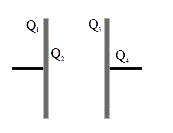Two identical metal plates are given charges and respectively. If they are brought close together to form a parallel plate capacitor with capacitance C, what will be the potential difference between the plates?Solution in Bengali
Step by step video & image solution for Two identical metal plates are given charges q_1 and q_2 (q_2 ltq_1) respectively. If they are brought close together to form a parallel plate capacitor with capacitance C, what will be the potential difference between the plates? by Physics experts to help you in doubts & scoring excellent marks in Class 12 exams.
Updated on:21/07/2023Topper's Solved these Questions
Similar Questions
A bar magnet is quickly moved towards a conducting loop having a capacitor as shown.

Predict the polarity of the plates A and B of the capacitor.
View SolutionTwo spheres, each having mass m are suspended from a common point by two insulating strings of length l. The spheres are identically charged and the separation between the spheres is 'd' . Find the charge on each sphere.
View SolutionTwo identical metal plates are given poistive charges Q1 and Q2 (<Q1) respectively. If they are now brought close together to form a parallel plate capacitor with capacitance C, the potencial difference between them is
View SolutionCharges Q_1 and Q_2 are given to two plates fo a parllel plate capacitor. The capacity of the capacitor is C . When the switch is closed , mark correct statement (s) . (Assume both Q_1 and Q_2 to be positive).
View Solutionकिसी आवेशित समांतर प्लेट संधारित्र की प्लेटों के बीच विभवांतर में क्या परिवर्तन होगा यदि- (i) प्लेटों को परस्पर निकट लाया जाये,
(ii) प्लेटों को दूर ले जाया जाये?
View Solutionधातु की दो समरूप प्लेटों को q1 और q2 आवेश इस प्रकार दिये जाते हैं कि q2<q1 अब दोनों प्लेटें एक-दूसरे के समीप लायी जाती हैं ताकि दोनों प्लेटें धारिता C वाले समांतर प्लेट संधारित्र का निर्माण कर सके। प्लेटों के बीच विभवान्तर ज्ञात कीजिए।
View SolutionTwo identical metal plates are positively charged to Q_1" and " Q_2(Q_2 lt Q_1) . If they are brough near each other to form a parallel plate capacitor of capacitance C, then what will be the potential differences between the plates?
View Solutionदो एक जैसी धात्विक प्लेटों को क्रमशः q1 और q2 आवेश (q2<q1) दिया गया है। यदि ये दोनों प्लेटें आपस में पास लाकर एक समान्तर प्लेट संधारित्र की धारिता C है, बनाया जाये, तो इन प्लेटों के मध्य विभवान्तर ज्ञात कीजिए।
View SolutionThe charges on the two plates initially (at = 0) are Q_1 and Q_2 . Long time after closing the key, the charges on the outer and Inner of plate 1 are, respectively (C = capacitance of capacitor )
View Solutionदो एकसमान धातु प्लेटों पर क्रमशः धन आवेश Q1,Q2,Q3 तथा Q4 दिये गये हैं । अब यदि इन प्लेटों को पास लाकर C धारिता का समान्तर पट्टिका संधारित्र बनाया जाता है, तब प्लेटों के बीच विभवान्तर होगा

View SolutionSuppose a charge +Q1 is given to the positive plates and a charge −Q2 to the negative plate of a capacitor. What is the "charge on the capacitor"?
View SolutionCharges Q1 and Q2 are given to two plates fo a parllel plate capacitor. The capacity of the capacitor is C. When the switch is closed , mark correct statement (s) . (Assume both Q1 and Q2 to be positive).

View SolutionTwo identical metal plates are given poistive charges Q1 and Q2 (<Q1) respectively. If they are now brought close together to form a parallel plate capacitor with capacitance C, the potencial difference between them is
View SolutionTwo identical metal plates are given positive charges Q1andQ2(<Q) respectively. If they are now brought close together to form a parallel plate capacitor with capacitance C, the potential difference between them is
View SolutionTwo identical metal plates are given poistive charges Q1andQ2 Q2 is smaller than Q1 respectively. If they are now brought close together to form a parallel plate capacitor with capacitance C, the potencial difference between the plates?
View Solution
